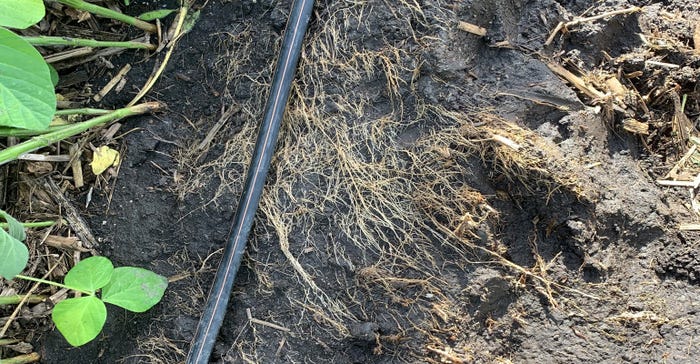
Thirty-inch rows aren’t Precision Planting agronomist Jason Webster’s preferred spacing when it comes to growing high-yield soybeans. But they’re a necessary evil at the Precision Technology Institute farm in Pontiac, Ill. Any narrower, and he’d risk running over plants.
“With our 15-inch or sometimes 20-inch-row beans, they’re generally easier to achieve high yields with. The problem is, some beans live and some beans die when you run them over. It brings variability into our testing process. I don’t want any background noise,” he says.
While the wide rows gave more space to weeds — and they were delayed in planting by about a month compared to 2018 — Webster’s team still harvested 65 bushels per acre from soybeans planted April 26. That’s about 2 fewer bushels than the latest soybeans he planted in the trial on June 10.
Webster says unlike in 2019, early-planted soybeans were the clear winner in 2018. And at 84 bushels per acre, they outyielded late-May-planted soybeans by 28 bushels. Illinois led the country in soybean production in 2018 in part because of the prevalence of early planting. The state took the mantle again in 2019, albeit with 20% fewer bushels because of delayed and prevented planting.
In 2019, the Precision Planting plot soybeans planted early had to contend with wet conditions that hampered growth, though pattern tile helped move water off the field, Webster says. He says while rain prevented another record-breaking harvest like 2018, he still got both early- and late-planted soybeans off to a good start, which resulted in not much of a difference in yield between either.
How they did it
2019 was the first year since Precision Planting bought the Pontiac site in fall 2017 that the team ran irrigation on soybeans. They also applied a starter fertilizer with their Conceal product, placing nutrients 3 inches to the side and 1.5 inches above where the soybean seed was planted.
Along with the new drip lines placed in the middle of the 30-inch open spacings between rows, this caused the taproot of the soybean to turn fibrous early in the season. Roots horned sideway toward the water and nutrients, resulting in a root system similar to that of corn. This helped the crop branch out more, rather than just growing taller.
“The idea is to get the bottom third of that plant to branch out so I can double the amount of beans. And that’s what happened,” Webster says.

HIGH YIELDS: Jason Webster attributes high-yield soybeans in 2019 to starter fertilizer and irrigation between the rows, which caused a more fibrous root system to grow.

While soybeans can take in nitrogen from the air when they’re further along in the growing season, using a starter fertilizer got the crop off to a good start with a 30% nitrogen application, along with ammonium polyphosphate, ammonium thiosulfate and potassium acetate.
“Those are four products that are widely available, and they’re relatively cheap, but they are salty. You can never put them in-furrow next to the seed,” Webster says. “I say that’s OK, because we’re 3 inches away from where the seed’s at — actually a little higher than the seed. So, it’s safe. And these beans are just loving it.”
Closing system
In addition to the fertilizer boost early in the season and irrigation, which especially came in handy during dry spells in July and August, Webster says there was another factor at play that aided yields in one of the most difficult years for high-yield soybeans he’s ever experienced: Precision Planting’s FurrowForce closing system.
He stresses that closing systems are most important to achieving consistent emergence with corn, as inconsistent emergence with soybeans doesn’t impact yields as severely. But it is still a factor. Neighboring soybeans will still cast a shadow over late emergers.
When a closing system is manually set to one setting for an entire field, the pressure isn’t ideal for every spot in the field, resulting in trenches left open, where soybean seeds are visible. That seed emerges later than its neighbors, because it must rely on the next rain to close the trench and allow germination to happen. FurrowForce, however, has a sensor module that adjusts the closing system for the variable moisture environments a planter goes through.
“Those guys that are 24 to 42 hours later coming up out of the ground, that’s where the yield loss is coming from,” Webster says, adding that in strip-till environments, when comparing FurrowForce to competing closing systems without the same sensor, his company’s system didn’t come out as the top yielder.
“We came in the spring with that planter right over top of the strip. It was an easy environment to close. FurrowForce actually got beat in these studies. We didn’t need the sensor. It wasn’t as important. And you’ll have those years. But I still like to have the flexibility to where if we get into tougher conditions, we can react,” Webster concludes.
About the Author(s)
You May Also Like




